Nomogram to predict the risk of endoscopic removal failure with forceps/baskets for treating submandibular stones
lNTRODUCTlON
Endoscopic stone removal,in which stones are removed with forceps/baskets during endoscopy,plays an important role in treating salivary lithiasis[1-5].For most surgeons and patients,endoscopic stone removal is favored because of its high visibility and minimal invasiveness.However,studies in recent years have found that many submandibular stones fail to be removed by the forceps/baskets under endoscopy,which means endoscopic removal failure(ERF)in treating submandibular stones is not unusual[6-8].Fruitless attempts to repeatedly perform endoscopic removal with forceps/baskets will greatly prolong the operation time and increase the risk of severe postoperative complications,such as ductal avulsion and perforation[5,9].Therefore,the clinical features of the stones should be carefully considered when selecting endoscopic removal,which has pros and cons[2,3,10].Currently,however,a broad consensus has not been reached regarding the indications of endoscopic removal for submandibular stones,leading to improper surgical choice in some cases[7,8].
Therefore,in this study,we aimed to identify the risk factors for ERF and construct and validate a predictive nomogram,a useful statistical tool,to identify the risk of ERF preoperatively when treating submandibular stones and to aid in clinical therapeutic decision making.
MATERlALS AND METHODS
Patients
This retrospective study enrolled patients with submandibular stones treated at the Hospital of Stomatology,Sun Yat-Sen University,from January 2012 to December 2020.The inclusion criteria were as follows:(1)availability of complete clinical information and CBCT images;(2)attempted stone localization by introducing an endoscope through the ductal orifice and removal with forceps or baskets under the endoscope;and(3)satisfactory surgical outcomes without residual stones.The detailed exclusion criteria and data screening process are shown in Figure 1.
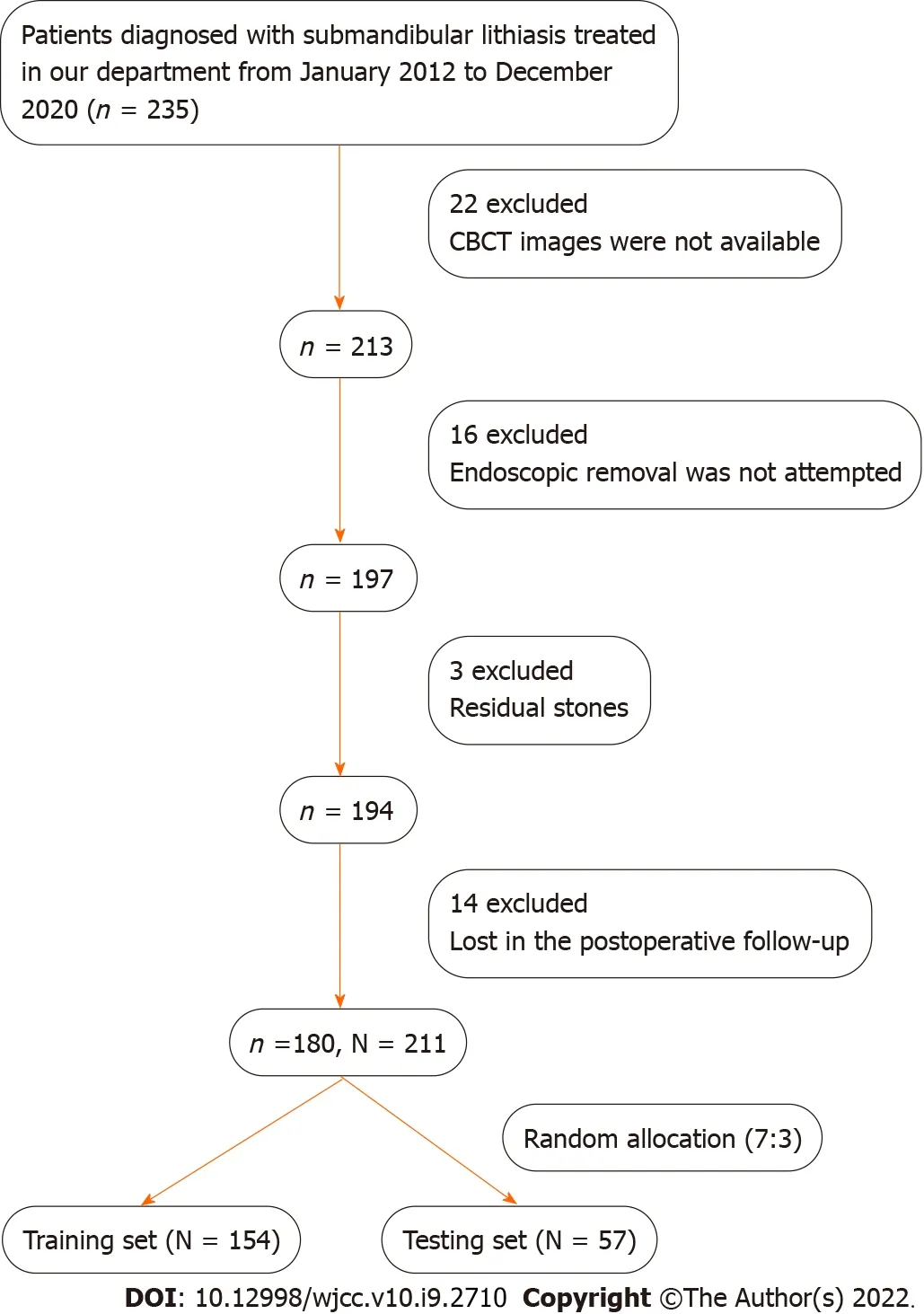
Ethics
The study was approved by the Medical Ethics Committee of Hospital of Stomatology,Sun Yat-Sen University(No.KQEC-2019-41)and was performed in accordance with the Declaration of Helsinki in regard to medical protocols and ethics.
Data acquisition
Clinical data,including sex,age,intraductal stone treatment history,involved sides,number of stones in the same gland,palpation,CBCT images(New Tom Inc.,Italy),and results of endoscopic removal were collected for the patients who met the criteria.The average location,transverse diameter(TD)and longitudinal diameter(LD)of all the stones on CBCT images were recorded after evaluation by 3 blinded experienced surgeons.As demonstrated in Figure 2,the location of the stone was defined as the distance between its anterior edge and the midpoint of the glossal bony cortex of the mandible in axial CBCT views.The TD of the stone was defined as the maximum width on its axial,coronal and sagittal sections.The LD of the stone was defined as its maximum length on the axial CBCT views.We attempted to remove all of the stones included in our study with forceps or baskets after locating them with an endoscope(Karl Storz Inc.,Germany),as shown in Figure 3.All endoscopic removals were performed by the same three experienced surgeons(Q.T.,G.L.,and H.L.).
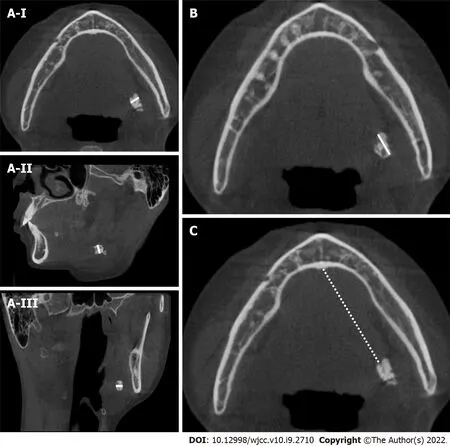
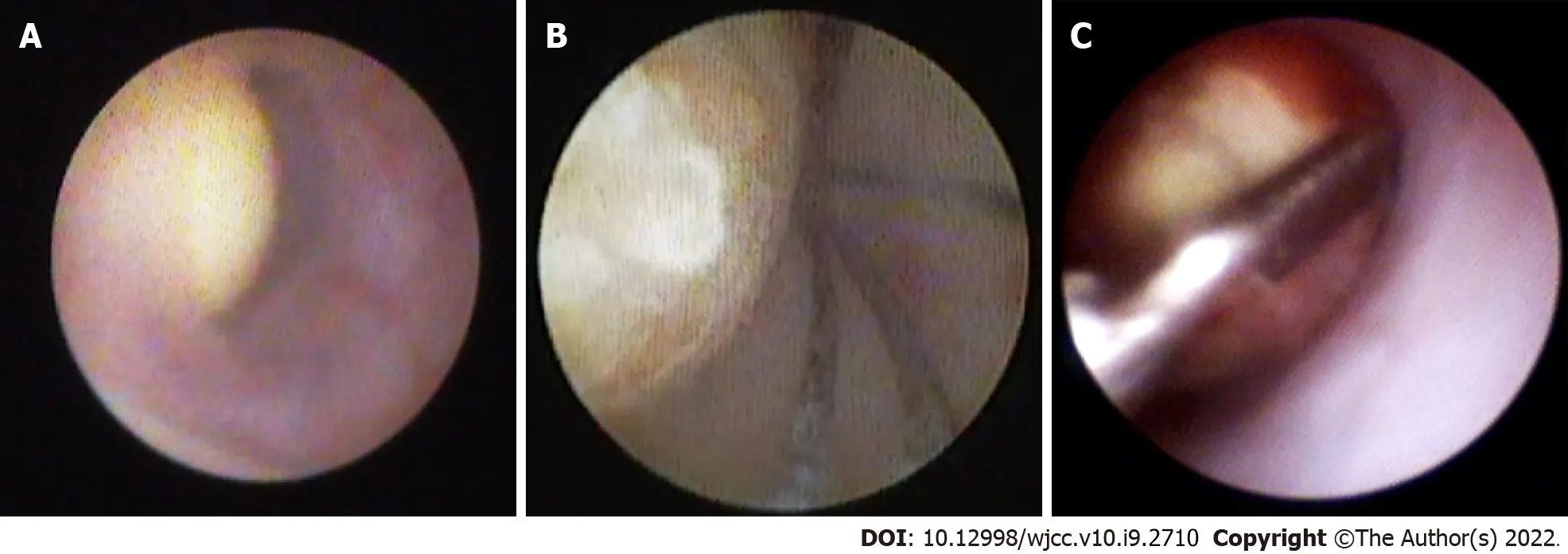
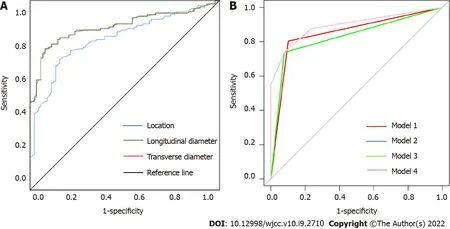
Statistical analysis
The preoperative clinical data of submandibular stones attempted to be treated by endoscopic removal with forceps/baskets in our department from January 2012 to December 2020 were collected.Correlations between clinical variables of the stones and ERF were explored by Pearson’s chi-squared test.Univariate and multivariate logistic regression analyses were then used to identify the independent risk factors of ERF.Finally,the nomogram based on the independent risk factors was constructed and validated to predict the risk of ERF for individual submandibular stone.
Thirty-four stones were confirmed to have an intraductal stone treatment history,such as intraductal irrigation and intraductal dilatation,which might result in ductal stenosis after the treatment.A total of 52.6% of the stones involved the glands on the right side.Thirty-one stones were found to be multiple,and 77 were unpalpable.The average location,TD and LD of the stones were 3.48 ± 1.51 cm,5.17 ± 2.01 mm and 4.97 ± 1.48 mm,respectively.Endoscopic removal was successful in 89 cases but failed in 122 attempts.The preoperative clinical variables of all the enrolled stones are shown in Table 1.
Pearson’s chi-squared test was used to explore the correlations between the clinical variables of the stones and ERF.Next,univariate and multivariate logistic regression analyses were used to identify the independent risk factors.Then,ROC curve analysis was carried out,and the area under the curve(AUC)was calculated to assess the predictive performance of the univariate and multivariate combined models.For the model with the best predictive performance,Youden's index was calculated to determine the optimal cutoff value,and the accuracy,sensitivity,specificity,positive predictive value(PPV)and negative predictive value(NPV)were calculated to evaluate the model.
Establishment and validation of the nomogram
All stones were randomly divided into the training and testing sets at a ratio of 7:3 using an R-generated random number(random seeds of 123).With the ‘rms’ package in R software(version 4.0.3)and based on the training set,a nomogram was constructed using the independent factors from the best model above to identify the risk of ERF.The predictive performance of the nomogram was evaluated by calibration curves and the C-index.
RESULTS
Clinical features of the enrolled patients and stones
A total of 180 patients with 211 stones who underwent endoscopic removal attempts were finally included in further analyses;100 of the patients were female.The average age of the patients was 41.4 ± 13.5 years old(17-75 years old).
At length, when he thought they had reached a safe distance, he began to lower his flight, and gradually descending23 to earth, deposited his burden in a flowery meadow
Receiver operating characteristic(ROC)curve analysis was performed,and Youden’s index was calculated to determine the optimal cutoff points for the location,TD and LD of the stones.According to the new classification criteria of the World Health Organization,44 years was considered the cutoff value for age.
Correlations between clinical features of the stones and ERF
The optimal cutoff points for the location,TD and LD were 3.76 cm,4.97 mm and 5.14 mm,respectively,as demonstrated in Figure 4A and Table 2.These three factors,together with the age of patients,were then used to divide patients into subgroups according to the cutoff values in further statistical analysis.Correlations between the clinical features of the stones and ERF are shown in Table 3;palpation(< 0.001),location(< 0.001),TD(< 0.001)and LD(< 0.001)were significantly associated with ERF.
With his huge club he aimed a terrific blow at Narcissus, which must certainly have killed him but for the adroitness58 of the Fairy Melinette, who arrived upon the scene just in time to snatch him up and carry him off at lightning speed to her castle in the air
Identification of the independent risk factors and predictive performance comparison
As demonstrated in Table 4,three independent risk factors were identified by univariate and multivariate logistic regression analyses,including the location(OR = 8.796,95%CI,3.673-22.661,= 0.040),TD(OR = 10.287,95%CI,3.301-35.269,< 0.001)and LD(OR = 4.412,95%CI,1.256-15.575,< 0.001)of the stones.
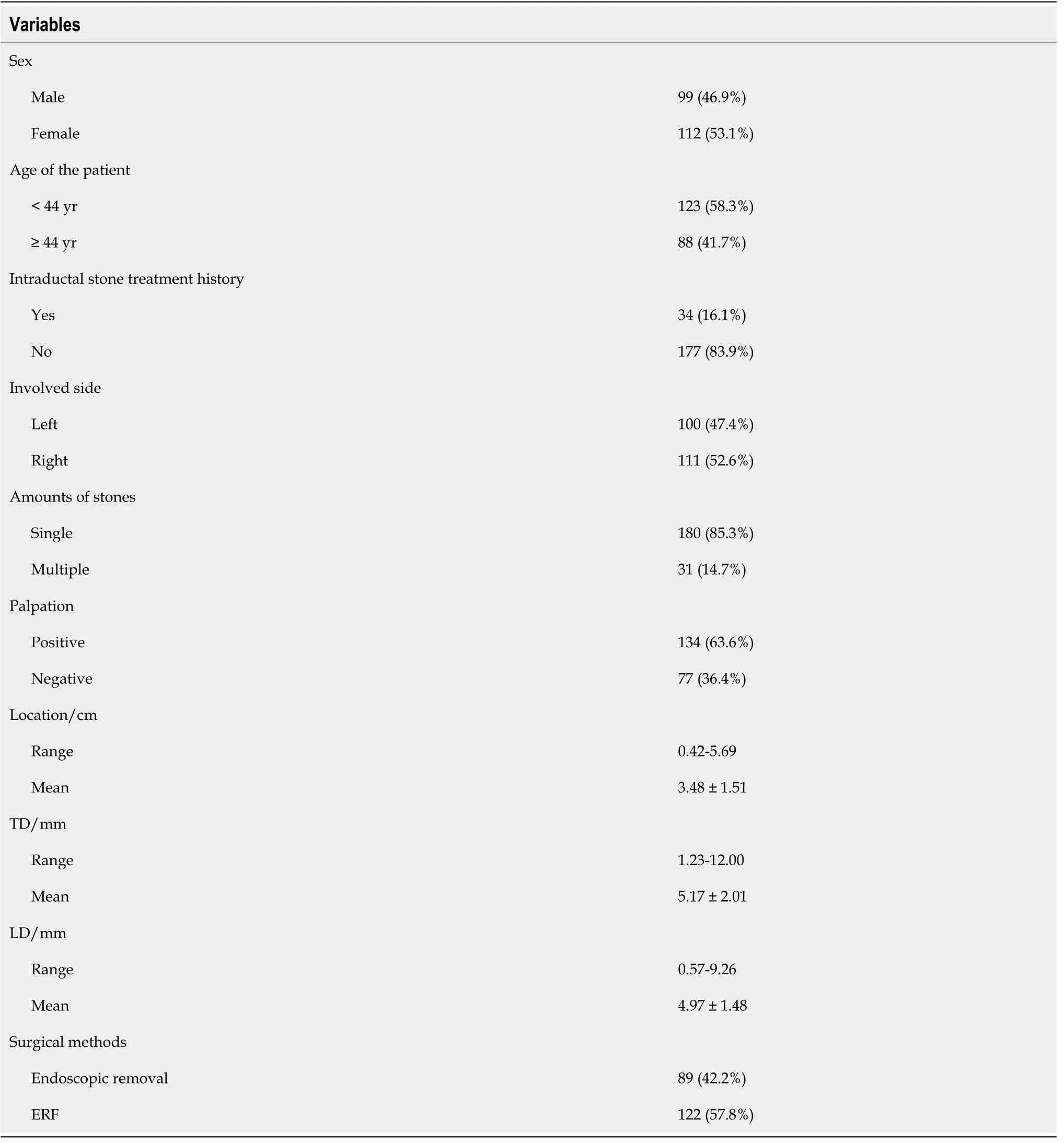

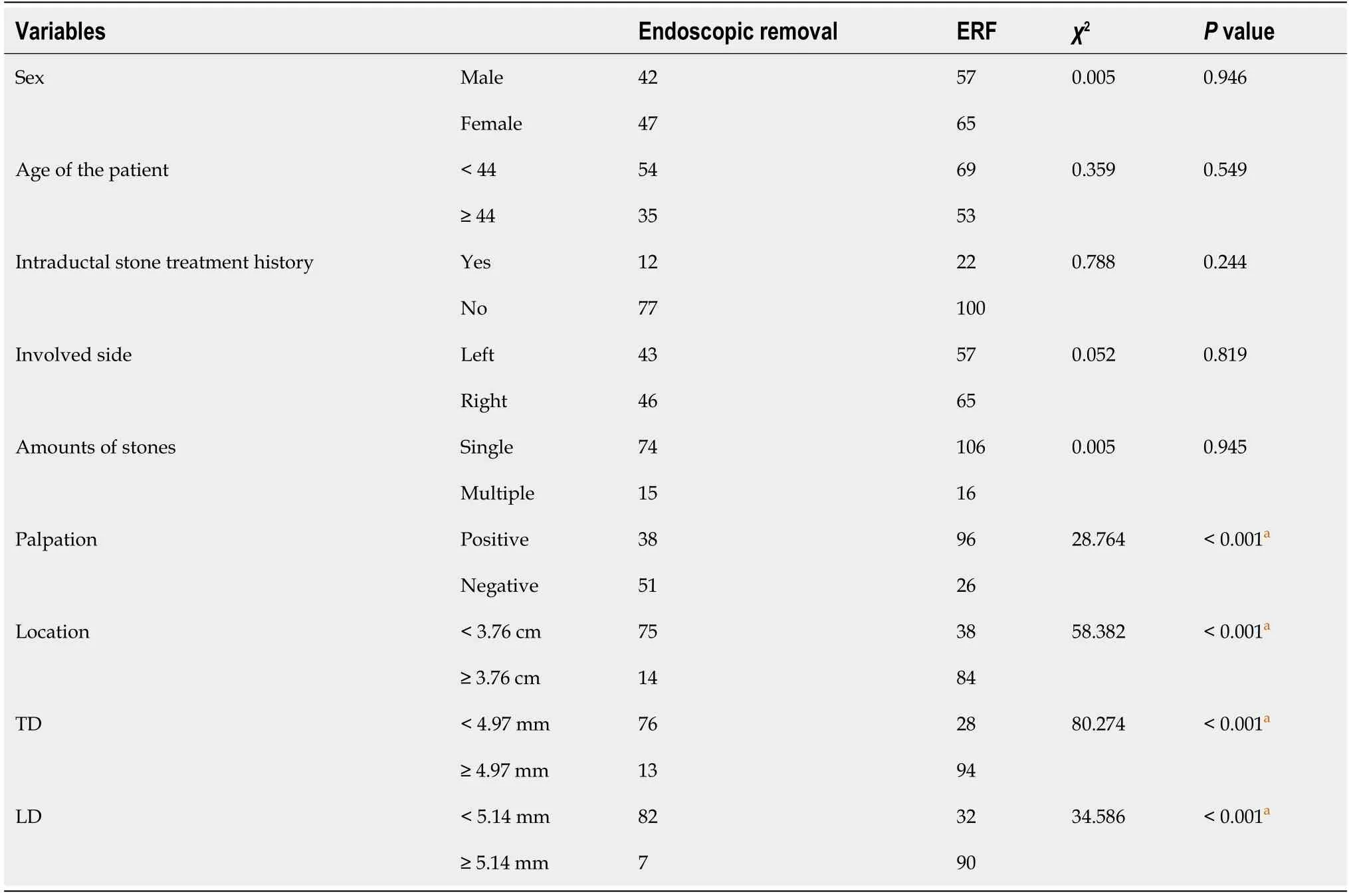
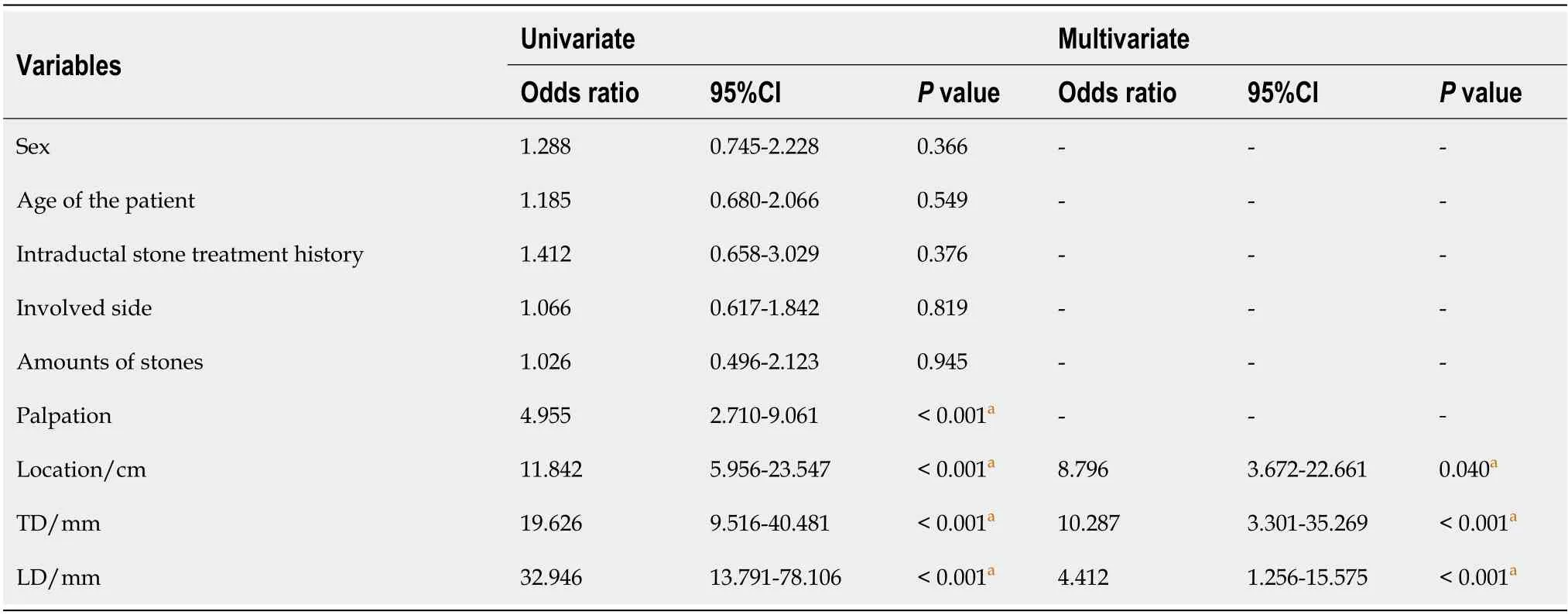
If the risk of ERF can be predicted before the surgery,unsuccessful endoscopic removal can be avoided to a large extent,and the patients will be able to truly benefit from this minimally invasive procedure.Based on the clinical records of 211 stones at our institution,all preoperative factors that can fully and objectively reflect the clinical features of submandibular stones were collected.According to the results of Pearson’s chi-squared test and univariate logistic regression analysis,the palpation,location,TD and LD of the stones were associated with the outcomes of endoscopic removal.Multivariate logistic regression analysis finally identified stone location,TD and LD on cone beam computed tomography images as independent risk factors for ERF.
Construction and validation of the predictive nomogram
Informed consent was obtained from the patient for the publication of images.
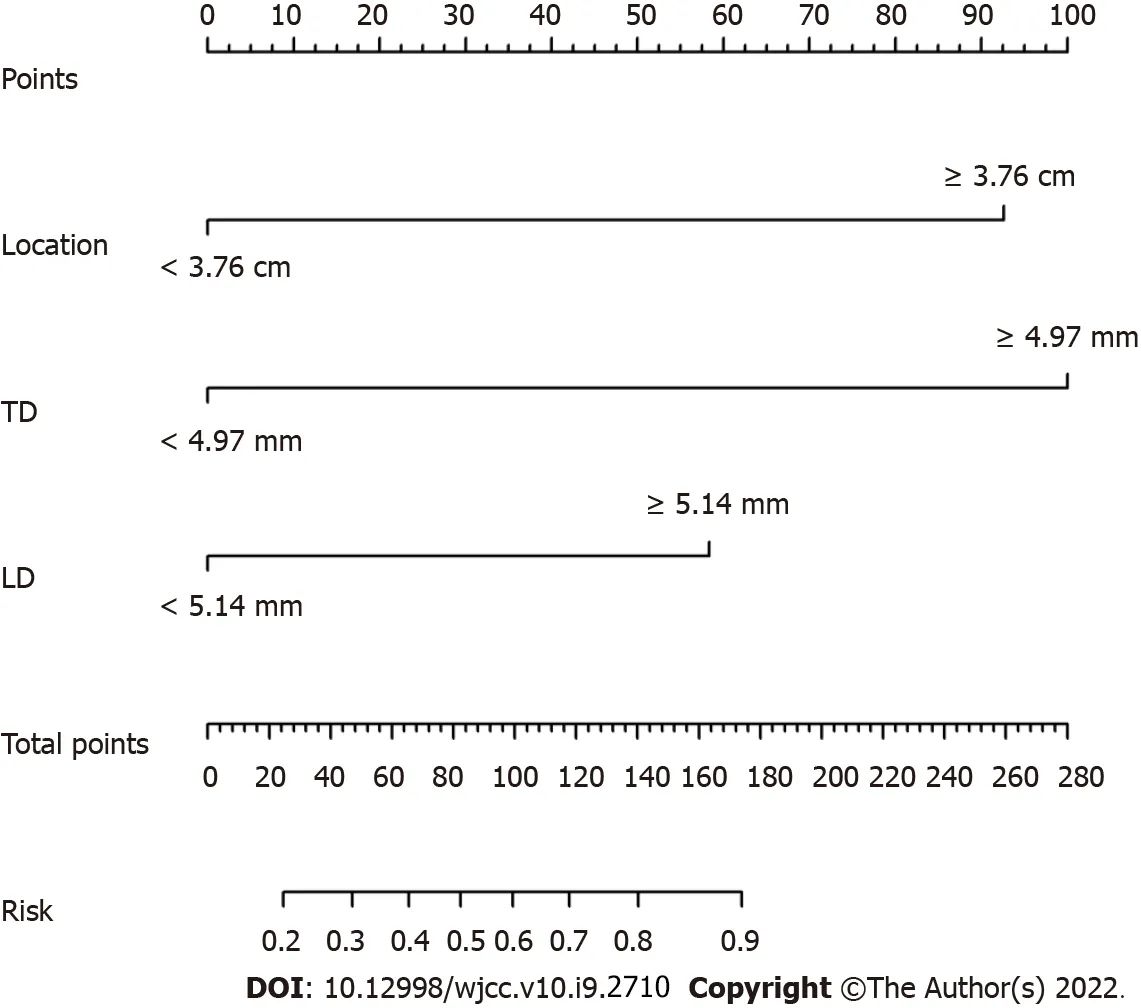

DlSCUSSlON
At present,the preservation of glandular functions and minimal invasiveness have become the focuses of treating submandibular stones[8,11,12].Endoscopic stone removal with forceps/baskets has allowed the incision-free treatment of submandibular stones and has been favored due to its ability to be directly visualized endoscopically and its minimally invasive nature.The procedure not only avoids the need for an incision but also helps with stone positioning,ductal expansion,plug removal,and tiny stone clearance.However,studies in recent years have found that endoscopic removal with forceps/baskets failed to achieve satisfactory therapeutic effects in some cases of submandibular stones[10,13].It hasbeen reported that the procedure might have limitations when removing the submandibular stones in the following cases[2,6,14,15]:(1)Posteriorly located stones;(2)very large stones;(3)irregular stones and(4)stones trapped by ductal stenosis.After repeatedly fruitless attempts at endoscopic removal,such submandibular stones still need to be removed with other surgical methods,such as transoral incision and even gland excision[7,8,16].Under these circumstances,repeated fruitless attempts with endoscopy and forceps/baskets will greatly prolong the operation time and increase the risk of ductal perforation,resulting in severe swelling of the submaxillary area and even postoperative airway obstruction.
Comparisons of the predictive performance of the univariate models and multivariate combined model are shown in Figure 4B.The multivariate combined model,based on the three independent risk factors,had the best predictive performance with an AUC of 0.920,accuracy of 84.8%,sensitivity of 77.9%,specificity of 94.3%,PPV of 95.0% and NPV of 75.7%.
The results of our study are consistent with those of previous studies[6,8,10,17].Cox[18]pointed out that the location and size of the stones significantly affected the success rate of endoscopic removal for submandibular stones.Kondo[10]found that the success rate of endoscopic removal for anteriorstones was higher than that for stones located in the posterior segment of the duct,and the transverse diameter of the stones was significantly correlated with successful endoscopic removal.Foletti[6]reported that submandibular stones located in the middle or posterior third of the duct with a transverse diameter less than 4 mm could be removed by forceps/baskets under endoscopy.Koch[17]believed that endoscopic removal could be adopted for anterior submandibular stones with transverse diameters less than 5 mm.Marchal[19]found that endoscopic removal could be selected when the transverse diameter of the stones was less than 3 mm.Fabie[8]believed that the benefits of applying other surgical methods to remove submandibular stones increased when the transverse diameter was greater than 6 mm.In the opinion of Walveka[15],the shapes and locations of the stones were the main factors that affected the success rate of endoscopic removal.However,previous studies have not proposed specific methods for measuring the preoperative location and size of submandibular stones and have not reached a broad consensus on the indications for endoscopic removal.
In contrast to previous studies,our current study first defined the specific methods for the preoperative measurement of stone location and size and used these measurable and objective independent risk factors to construct an effective nomogram for quantifying the indications for endoscopic stone removal.The midpoint of the glossal bony cortex of the mandible is regarded as the marker for measuring the stone location because it is close to the ductal orifice and can be clearly visualized on CBCT images.The distance between this point and the anterior edge of stones also represents the depth to which the endoscope and forceps/baskets should be lowered into the ductal system,providing guidance during the process of endoscopic removal.
Nevertheless,there are some limitations to our current study.Due to its retrospective nature,information bias may have been present during the data collection procedure.Additionally,this study was a single-center analysis,and a limited number of samples were included.It is essential to assess the nomogram at multiple institutes with a larger population.Moreover,our present model does not include anatomical variations of the Wharton duct,which can also affect the success rate of endoscopic removal but are difficult to inspect with preoperative examinations.Despite these disadvantages,this was the first study to construct a noninvasive predictive nomogram to predict ERF when treating submandibular stones preoperatively and that could serve as a reference for surgeons to personalize treatment plans for patients.
So the little lumps, with the wisdom that they had found, were sent to live in the world. And they felt loneliness, pain, and confusion. And as the Wumpalump had commanded they were fruitful and multiplied. But always with wisdom they looked to the nothingness and saw they lacked... so loneliness, pain, and confusion were multiplied.
CONCLUSlON
The location,transverse diameter and longitudinal diameter of submandibular stones on CBCT images are independent risk factors for ERF.A nomogram based on these three factors helps to predict the risk of ERF for submandibular stones.
ARTlCLE HlGHLlGHTS
Research background
The study was approved by the Medical Ethics Committee of Hospital of Stomatology,Sun Yat-Sen University(No.KQEC-2019-41).
Research motivation
To predict the risk of endoscopic removal failure(ERF)for submandibular stones based on their preoperative clinical features.
Then, for the rest of the wedding feast they gave him bread made with salt, and dishes with seasoning, and he said they were the very best he had ever eaten
Research objectives
In the current study,we aimed to construct a predictive model to figure out the risk of ERF for treating submandibular stones before the surgery.
Research methods
Statistical analyses were performed with SPSS 25.0 software(SPSS Inc.,Chicago),and the statistical methods of this study were reviewed by Zhi-Wei Li from the Department of Medical Statistics and Epidemiology,Sun Yat-Sen University.
Research results
The palpation,location,transverse diameter and longitudinal diameter of submandibular stones were significantly associated with ERF.And the location,transverse diameter and longitudinal diameter of submandibular stones on cone beam computed tomography images were independent factors for ERF with forceps/baskets.A nomogram based on these three factors had satisfying predictive efficiency.
Research conclusions
A nomogram based on the location,transverse diameter and longitudinal diameter helps to predict the risk of ERF with forceps/baskets for submandibular stones.
Research perspectives
Feasible preoperative measurements of anatomical variations of the Wharton duct are needed to be included in the further study.Also,it is essential to assess the predictive nomogram at multiple institutes with a larger population.
ACKNOWLEDGEMENTS
We thank Zhi-Wei Li for his help in statistical analyses.
FOOTNOTES
Tao Q and Huang Y designed the study;Huang Y,Liang PS,Yang YC and Cai WX performed the research;Huang Y,Liang PS and Yang YC contributed the analytic tools;Huang Y,Liang PS and Yang YC analyzed the data and wrote the manuscript;all authors have read and approved the final manuscript.
It was late in the evening before the crow returned. “Caw, caw,” he said, “she sends you greeting, and here is a little roll which she took from the kitchen for you; there is plenty of bread there, and she thinks you must be hungry. It is not possible for you to enter the palace by the front entrance. The guards in silver uniform and the servants in gold livery would not allow it. But do not cry, we will manage to get you in; my sweetheart knows a little back-staircase that leads to the sleeping apartments, and she knows where to find the key.”
Guangdong Basic and Applied Basic Research Foundation,No.2019A1515012139.
Recent studies have found that the favored minimally invasive endoscopic removal,in which clear stones with forceps/baskets,failed to remove submandibular stones in most cases.
A total of 154 stones were selected randomly for the training set,while the remaining 57 were included in the testing set.Based on the data from the training set,the location,TD and LD of the stones were incorporated when constructing the nomogram model for predicting the risk of ERF,as shown in Figure 5.Calibration curves of the nomogram are shown in Figure 6;good agreement was foundbetween the predicted and observed probabilities in both sets.The C-index of the model in the training set was 0.917(95%CI,0.875-0.959),and that in the testing set was 0.925(95%CI,0.862-0.989).
The authors declare that they have no conflict of interest to report.
She and her husband had lived in Vienna, Austria, and had opposed the Nazis14 before the Second World War. They decided15 to flee to Switzerland, but her husband said they must go separately. She left first. Later she heard that he had died in a concentration camp.
Statistical code and dataset are available from the corresponding author at taoqian@mail.sysu.edu.cn.
The Princess was the King and Queen s only child and it should come as no surprise that the little blacksmith loved her very much for she was both kind and beautiful. She was even smaller than he, and had dancing eyes and long silken hair which she wore in a coiled braid. But, alas3, the little blacksmith could admire the Princess only from afar because she was, after all, a princess and he but a lowly blacksmith--not even that tall. One day a terrible dragon came to the kingdom. Breathing fire on anyone who crossed its path, it trampled4 houses and burned fields. Many knights battled the dragon but their swords could not cut its thick scales. Each night it flew home to its cave in the mountains surrounded by a deep ravine.
11. Gold: Gold, as always, is a precious metal and was reserved for the wealthy in past centuries. Gold has often been used for money and jewelry, to represent wealth and power.
All the authors have read the STROBE Statement—checklist of items,and the manuscript was prepared and revised according to the STROBE Statement—checklist of items.
This article is an open-access article that was selected by an in-house editor and fully peer-reviewed by external reviewers.It is distributed in accordance with the Creative Commons Attribution NonCommercial(CC BYNC 4.0)license,which permits others to distribute,remix,adapt,build upon this work non-commercially,and license their derivative works on different terms,provided the original work is properly cited and the use is noncommercial.See: https://creativecommons.org/Licenses/by-nc/4.0/
China
Yun Huang 0000-0003-3374-1019;Pei-Sheng Liang 0000-0002-1262-6516;Yao-Cheng Yang 0000-0001-7995-6301;Wei-Xin Cai 0000-0002-9859-7460;Qian Tao 0000-0001-8172-7954.
Justin would rub my tummy and talk to his baby sister, telling her she had to wait a little longer because the fruit was not ready to be picked yet. His forays into the plum tree lasted longer each day, as if he was coaxing9 the tree to ripen10 quickly. He talked to the tree and thanked it for letting him know about this important event in his life. Then one day, it happened. Justin came running into the house, his eyes as big as saucers, with a plastic bucket full to the brim11 of juicy purple plums. Hurry, Mommy, hurry! he shouted. She s coming, she s coming! The plums are ripe, the plums are ripe!
Dana screamed for help. An airport supervisor3 appeared. He told Dana to get on the plane. Dana said that she was not moving until an ambulance arrived. The supervisor said her plane would leave without her. Dana said that she didn t care.
Liu JH
A
Liu JH
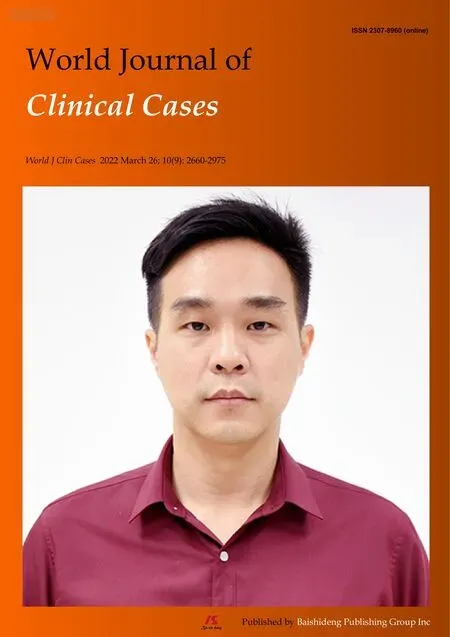 World Journal of Clinical Cases2022年9期
World Journal of Clinical Cases2022年9期
- World Journal of Clinical Cases的其它文章
- Malignant struma ovarii with papillary carcinoma combined with retroperitoneal lymph node metastasis:A case report
- Upper gastrointestinal bleeding from a Mallory-Weiss tear associated with transesophageal echocardiography during successful cardiopulmonary resuscitation:A case report
- lpsilateral hemifacial microsomia with dextrocardia and pulmonary hypoplasia:A case report
- Esophageal myoepithelial carcinoma:Four case reports
- Turner syndrome with primary myelofibrosis,cirrhosis and ovarian cystic mass:A case report
- Acute coronary artery stent thrombosis caused by a spasm:A case report
